鈕扣對於海水玩家而言應該不陌生。不過有趣的是雖然在水族圈中大家總會下意識的把這些動物叫做珊瑚,但在多數的學術文獻中其實比較不會將這個他們歸入「珊瑚」的範疇。
我們講的鈕扣是屬於菟葵目(Zoantharia)底下的一群動物,與石珊瑚、海葵 、 擬珊瑚、與黑珊瑚同屬於六放珊瑚,而接下來我便會簡單介紹一下菟葵這個類群。
一、基本分類

(來源:https://bmcgenomics.biomedcentral.com/articles/10.1186/s12864-020-06945-9)
上圖為六放珊瑚目前的親緣關係與分類(由上至下分別為石珊瑚、擬珊瑚、黑珊瑚、海葵、菟葵、管海葵、與八放珊瑚),可以看到菟葵目其實是六放珊瑚中的基群(basal group),也就是在演化歷史上最早分家出去的一群。
菟葵目底下目前有兩個大分支,分別為Brachycnemina與Macrocnemina,不過其分類與類群間的親緣關係仍有許多爭議。
二、Brachycnemina
Brachycnemina底下總共有三個科:
1. Sphenopidae
Sphenopidae包含了Palythoa和Sphenopus兩個屬:
(1) Palythoa
這個屬包含各種深水鈕扣、大綠鈕、地圖鈕等。Palythoa體內含有稱作Palytoxin的毒素,新聞上的鈕扣中毒事件多半就是這些傢伙搞的(部分其他菟葵也有Palytoxin但量通常比較少)。
另外他們還有個特點是生長時常會把一些沙子或粉塵納入共肉中所以質感會比較粗糙,因此也俗稱岩砂海葵。
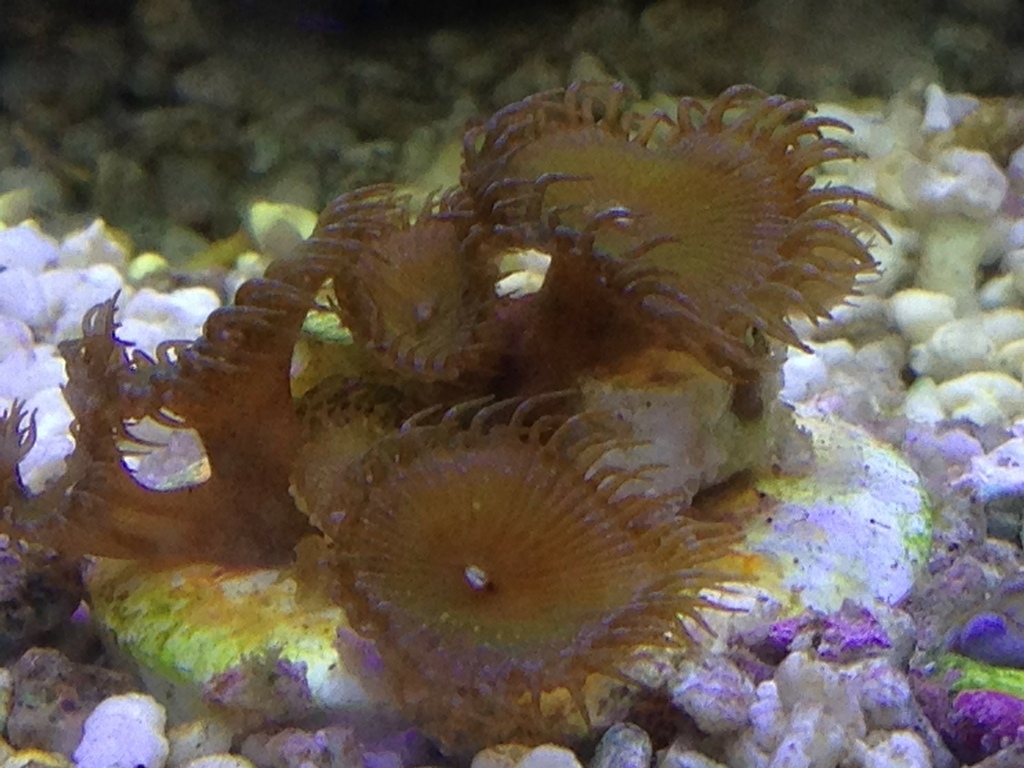
一般俗稱的深水鈕扣,可以看到觸手比較細尖,抓食物的能力也很不錯,上面這顆甚至能捕捉成年豐年蝦
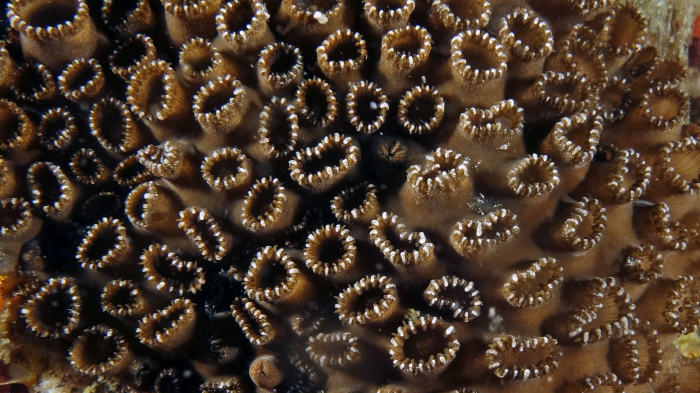
(來源:https://www.marinespecies.org/aphia.php?p=taxdetails&id=220520#images)
潮間帶常見的Palythoa tuberculosa
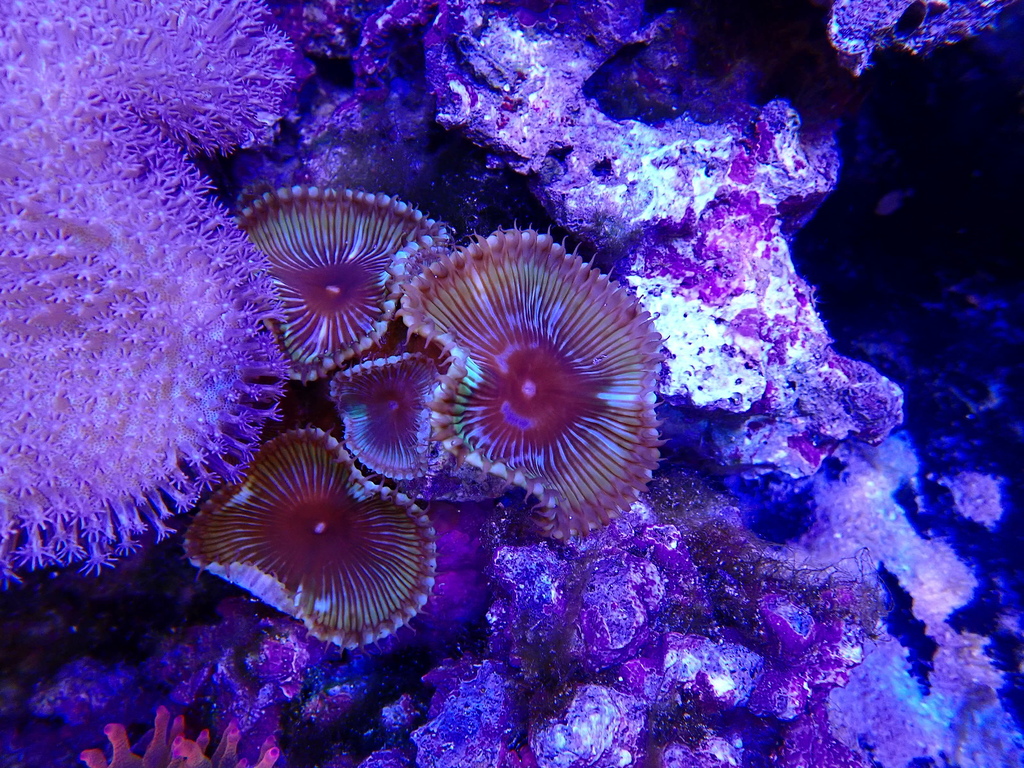
這個則是另一種經典款加勒比海地圖鈕(Palythoa grandis),市面上可以看到很多不同色系及花紋的strain
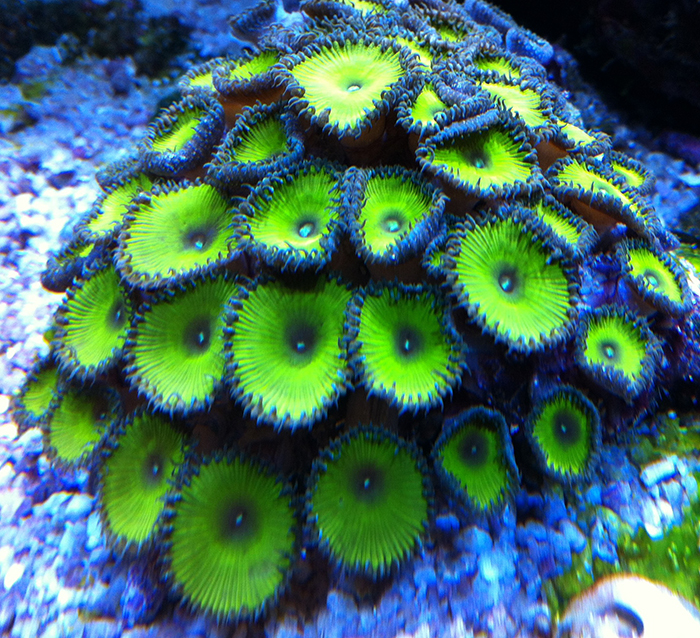
(來源:https://reefs.com/magazine/identify-this-zoanthids/)
一般我們俗稱的大綠紐也是常見的Palythoa
其他像是Nuclear Green、Purple/Red Death等比較有名的鈕扣也都是Palythoa。另外早期還有個屬叫Protopalythoa不過目前已經被併入Palythoa了。
(2) Sphenopus
Sphenopus與許多其他菟葵最不一樣的點在於他們通常會是單一一隻水螅體自己生長並非集體生活,不過由於沒什麼顏色變化故相當少見於水族貿易。
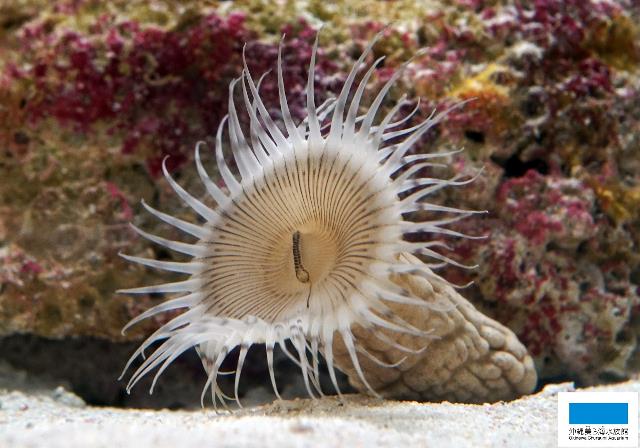
(來源:https://reefbuilders.com/2016/07/27/sphenopus-exilis-is-a-new-species-of-zoanthid-unlike-any-other/)
沖繩美麗海水族館所展示的Sphemopus marsupialis
2. Zoanthidae
Zoanthidae底下總共有三個屬:
(1) Zoanthus
水族市場中多數的鈕扣在分類上屬於這裡。Zoanthus的顏色變化非常豐富,市面上也有許多著名的命名strain,不過有時候很難分辨,因為就連不同物種也有可能出現類似的顏色型態。
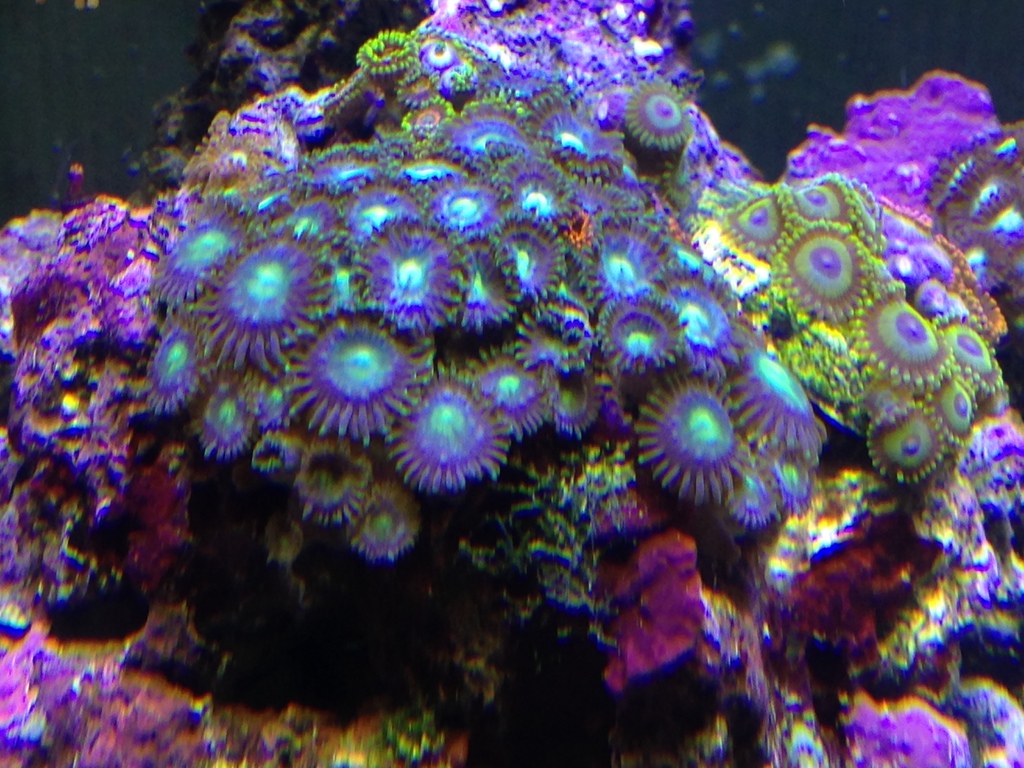
不同strain的Zoanthus
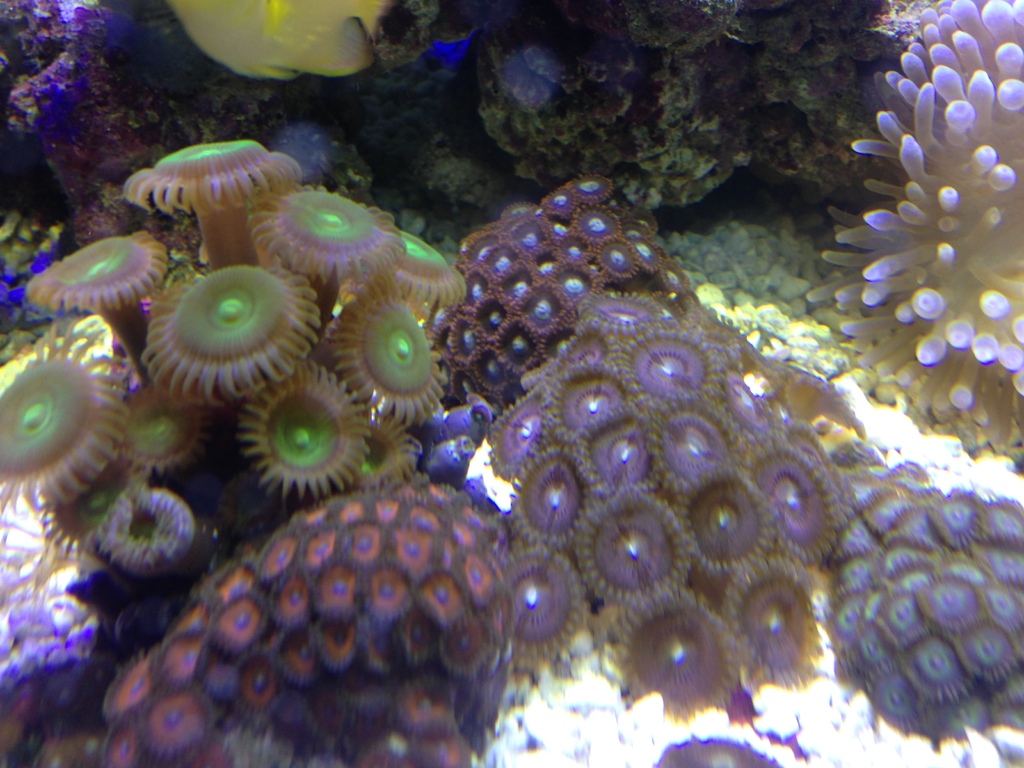
左上那顆雖然也常被叫大綠鈕但其實是屬於Zoanthus
(2) Isaurus
台灣好像幾乎沒看過有人特別進這東西,我之前養的也是從水館角落挖到的(可能是跟著別的東西進來的)。英文俗稱為snake polyp,我習慣翻成蛇鈕扣。
與其他鈕扣不同的是共生藻及螢光蛋白都在水螅體脖子部分,觸手及oral disc則是白的,通常白天會整坨垂下來到了晚上會立起來開花。
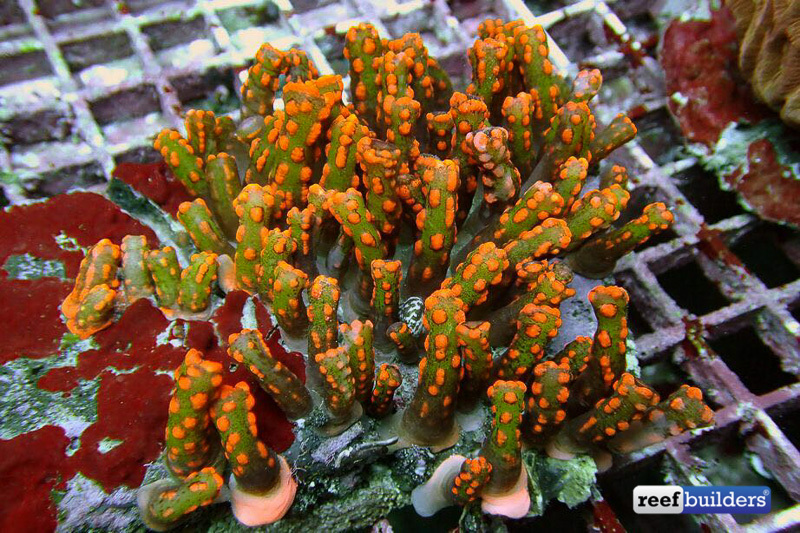
(來源:https://reefbuilders.com/2017/03/06/saint-patricks-snake-polyps-craziest-zoanthids-ever/)
俗稱Saint Patrick的strain
(3) Acrozoanthus
Acrozoanthus的特徵為他們通常會長在磯沙蠶(Eunice)所製造的管子上,所以也常會被稱作水螅樹。與Zoanthus的親緣關係相當近,不過由於生長方式的差異故目前單獨分於一屬。
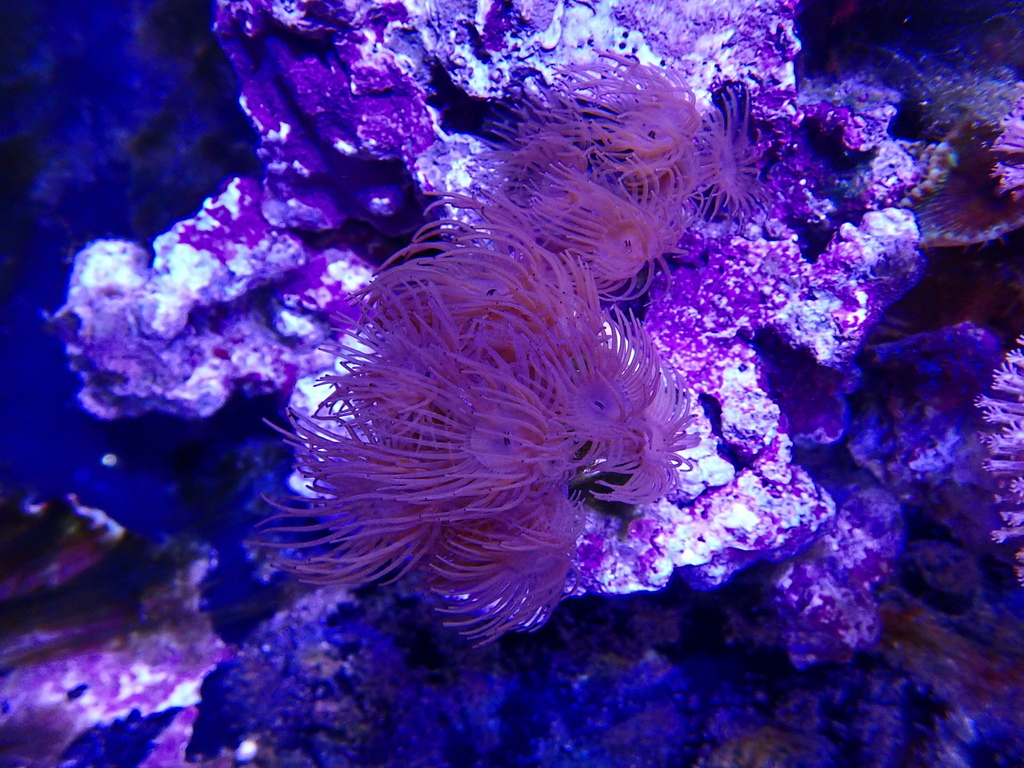
一小叢的Acrozoanthus
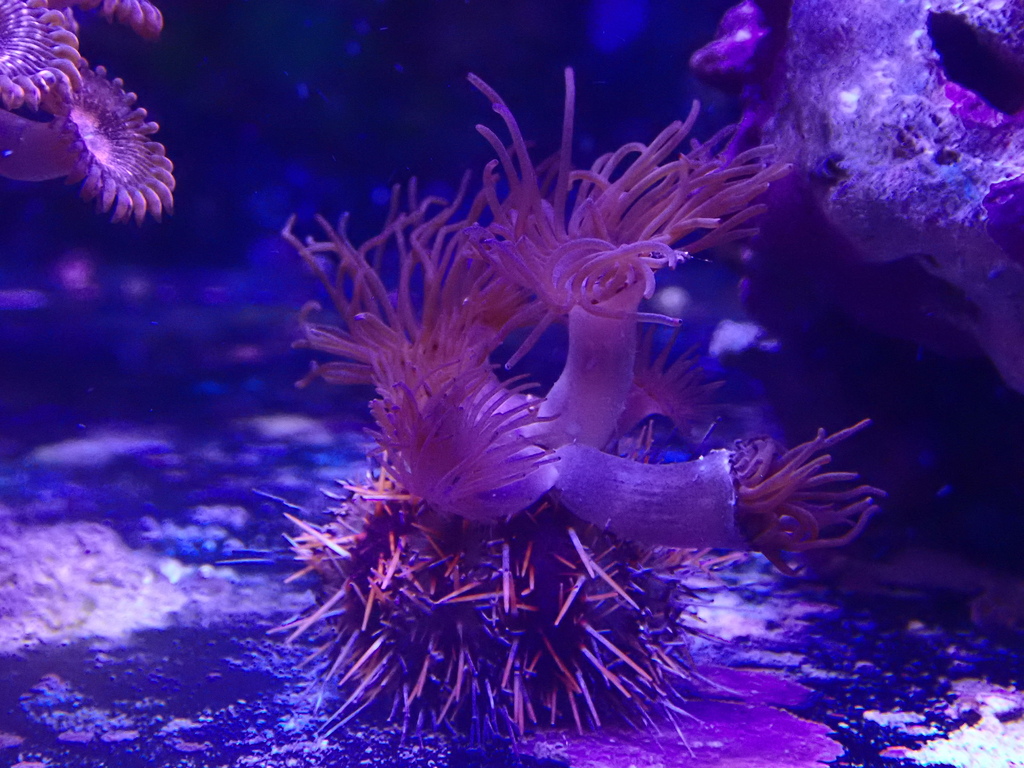
他們的附著能力相對其他菟葵而言其實還滿弱的,所以飼養時很容易發生像這樣被海膽等生物綁架的狀況
3. Neozoanthidae
Neozoanthidae底下有一屬三種,偶可見於水族市場。
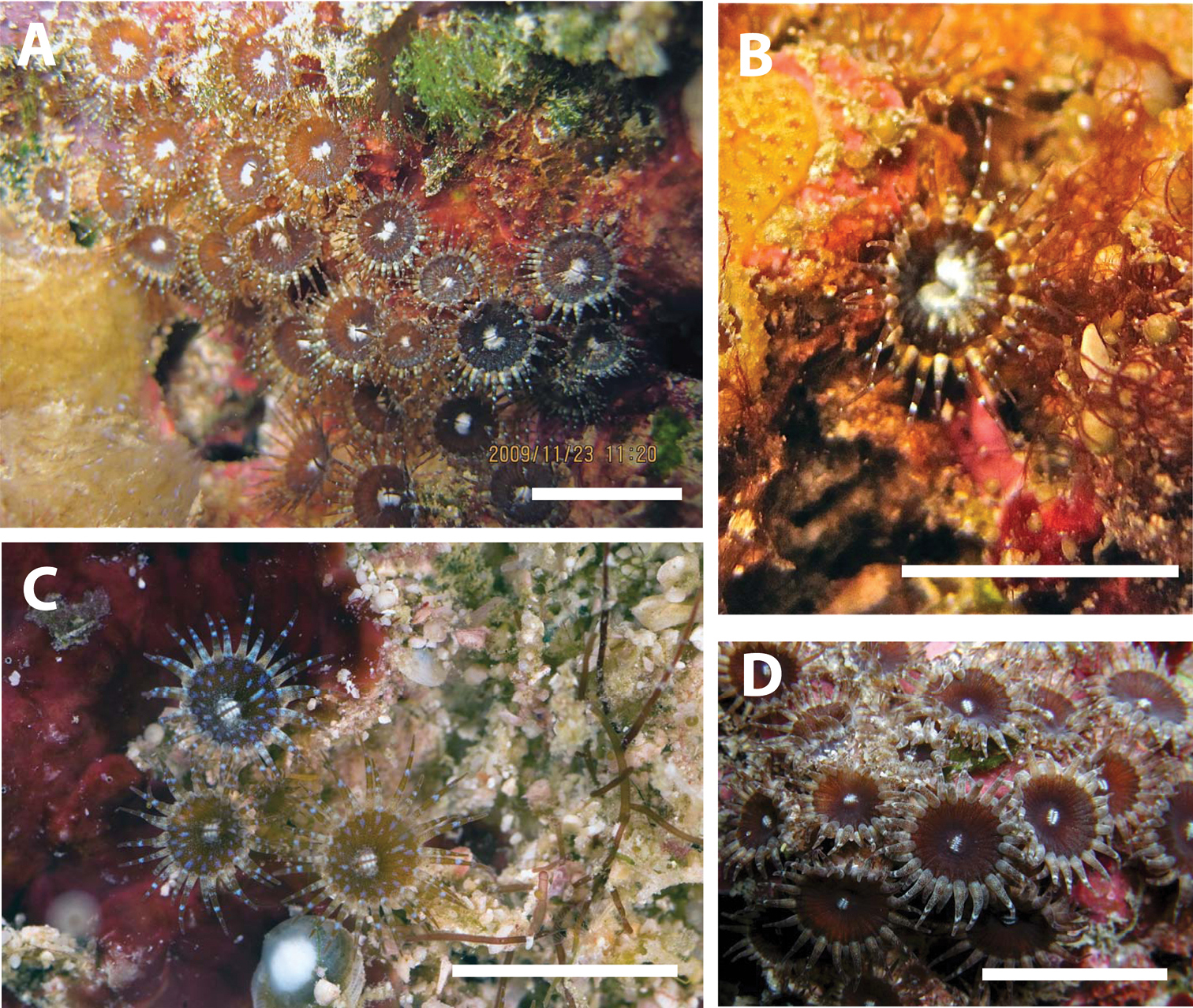
(來源:https://zookeys.pensoft.net/article/3398/)
大堡礁的Neozoanthus caleyi
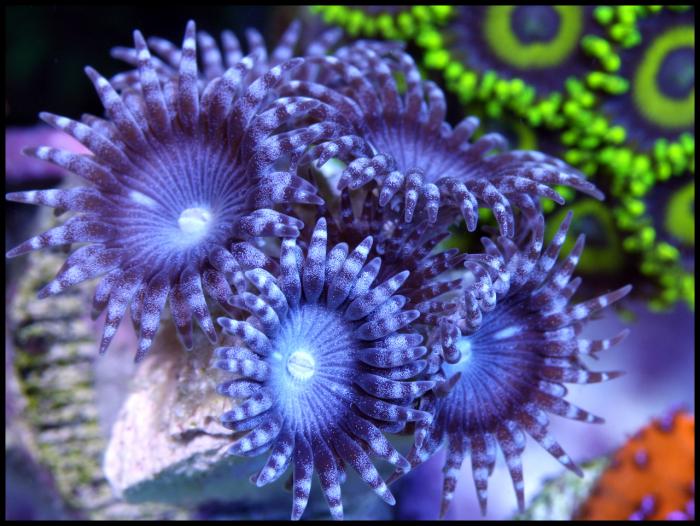
(來源:https://www.exoticfrags.us/s/product_info.php?products_id=459)
藍色的水族strain "Blue Shuriken"
三、Macrocnemina
Macrocnemina底下總共有五個科:
1. Microzoanthidae
這個科目前僅一屬兩種。水螅體較小且多無共生藻,少見於水族貿易。

(來源:https://www.inaturalist.org/observations/27554203)
印度西岸的Microzoanthus sp.
2. Nanozoanthidae
目前僅一屬一種。與Microzoanthus一樣水螅體相當小且少見於水族貿易,不過差異在於體內是有共生藻的。
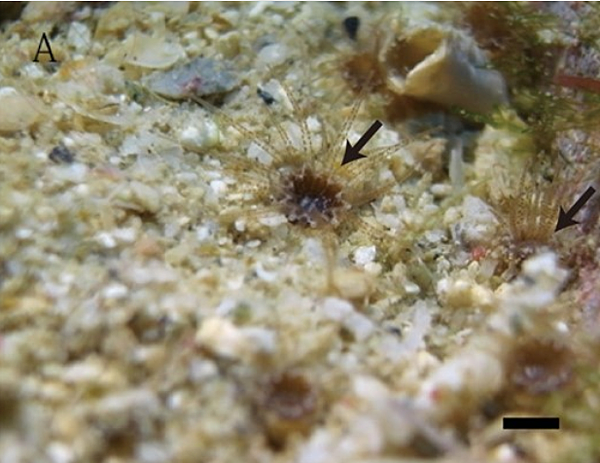
(來源:https://academic.oup.com/zoolinnean/article/169/3/509/2420782?login=false)
沖繩的Nanozoanthus harenaceus
3. Epizoanthidae
Epizoanthidae底下有兩個屬:
(1) Epizoanthus
Epizoanthus底下的物種多半不具共生藻。他們經常生長在海綿、珊瑚、水螅、甚至寄居蟹身上,因此同樣常被稱作水螅樹。
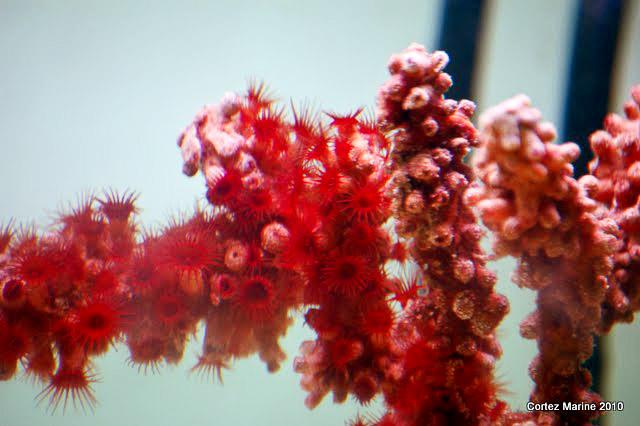
(來源:https://reefbuilders.com/2010/10/27/red-epizoanthus-cortez-marine-azoox-nps-reefers/)
生長在海樹上的Epizoanthus
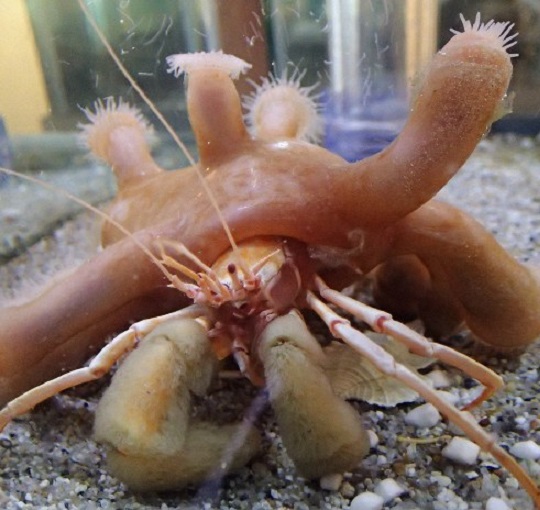
(來源:https://www.tandfonline.com/doi/full/10.1080/14772000.2019.1693439)
生長在寄居蟹殼上的Epizoanthus xenomorphoideus
(2) Thoracactis
Thoracactis屬下目前僅Thoracactis topsenti一種。無共生藻且通常生長於海綿上,少見於水族貿易。
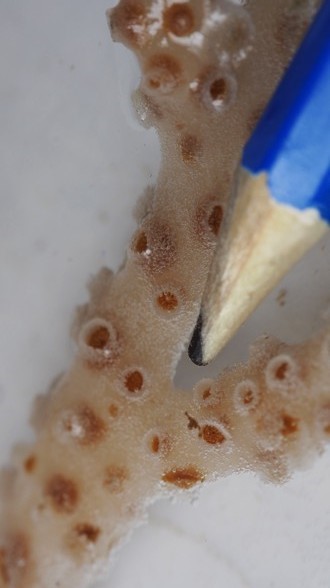
(來源:https://marinee-tech.blogspot.com/2018/11/a-stroll-in-sponge-gardens.html)
生長於海綿上的Thoracactis topsenti
4. Hydrozoanthidae
Hydrozoanthidae底下有Aenigmanthus、Hydrozoanthus、Terrazoanthus三個屬。
(1) Aenigmanthus & Hydrozoanthus
這兩個屬多半不具共生藻並偏好生長在一些深水的水螅或海樹上,少見於水族貿易。
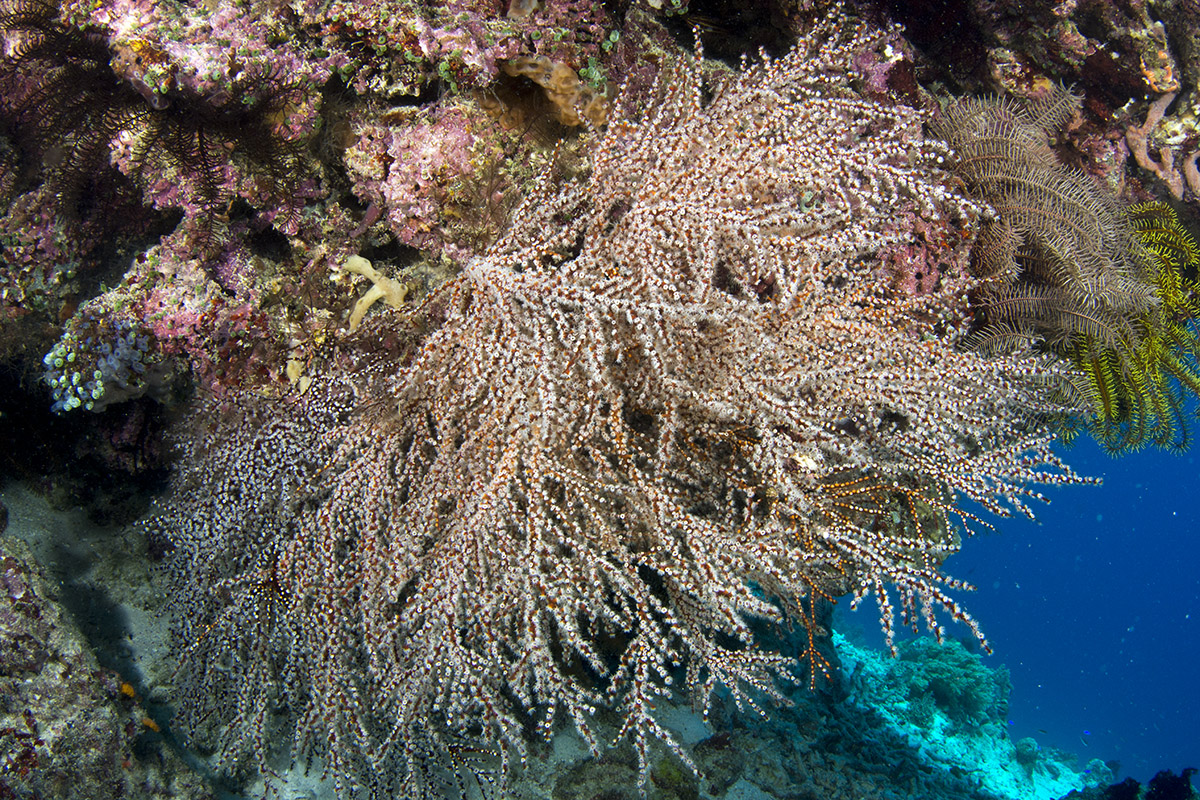
(來源:https://reefs.com/the-enigma-of-aenigmanthus-the-rise-of-epizoism/)
生長於群體水螅上的Hydrozoanthus sils
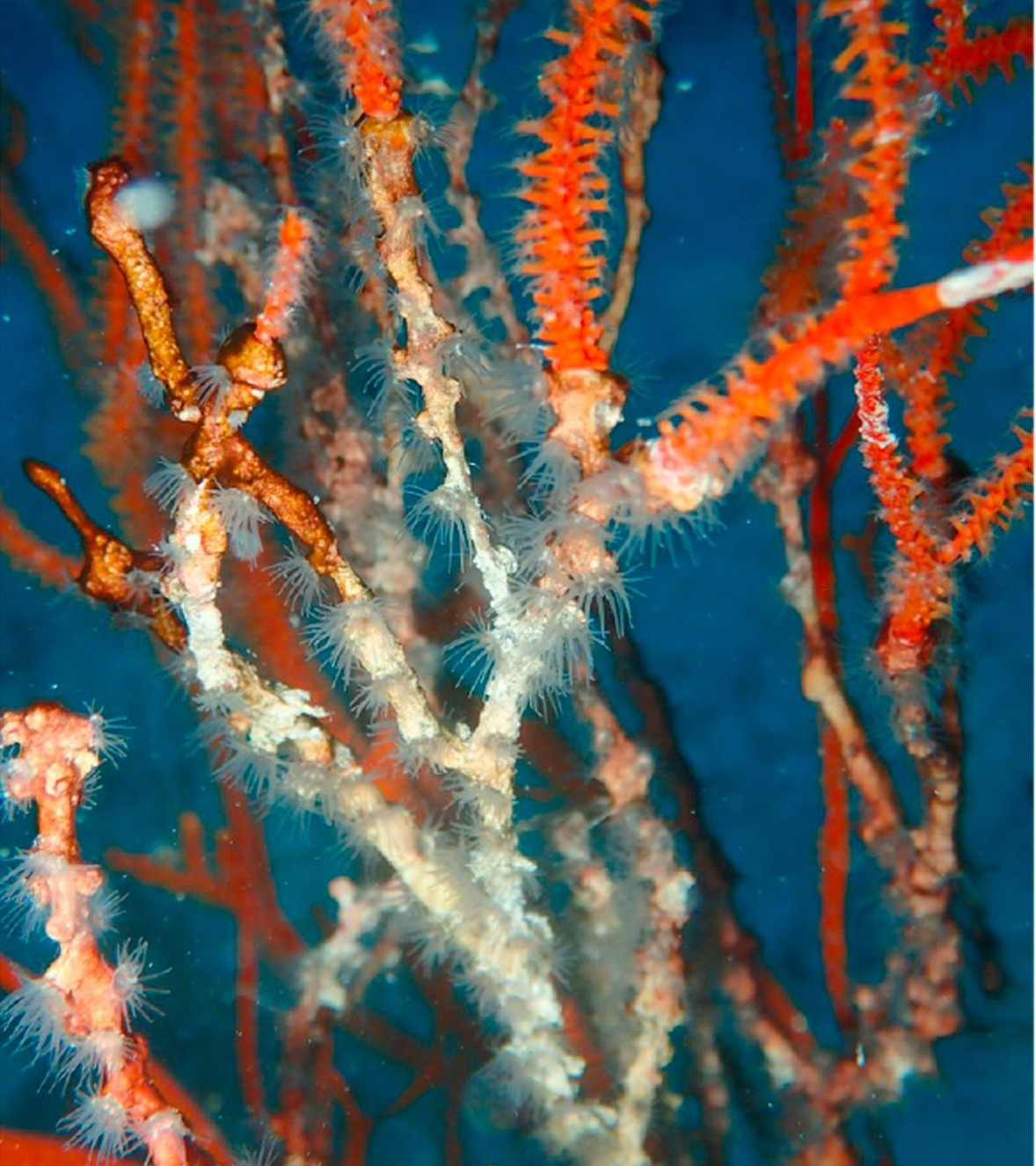
(來源:https://reefs.com/the-enigma-of-aenigmanthus-the-rise-of-epizoism/)
生長於海樹上的Aenigmanthus segoi
(2) Terrazoanthus
這個屬與上面兩個的差異在於他們通常不會長在其他生物身上且許多種類是有共生藻的,水族貿易中常見的黃水螅即是屬於這個屬。
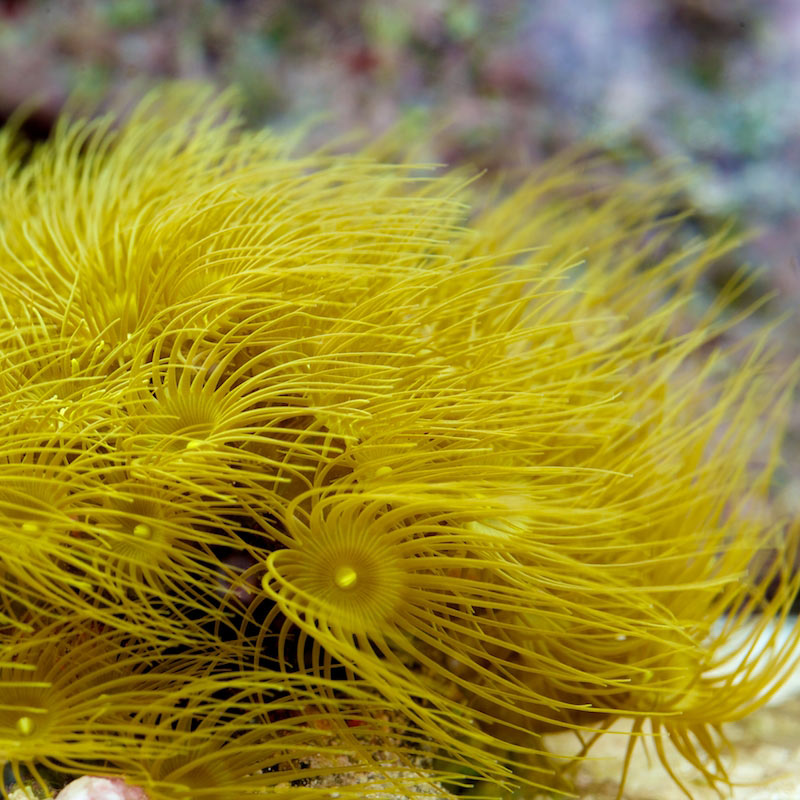
(來源:https://tidalgardens.com/stock-yellow-parazoanthus-polyp.html)
上圖這種Terrazoanthus就是我們一般俗稱的黃水螅。這東西的分類其實一直都有點爭議,不過2010年時Reimer等人透過基因定序分在Terrazoanthus這個屬。
牠們的生長速度非常快,算是雜草等級的東西,而且戰鬥力其實不算弱所以最好注意一下擺放位置。
5. Parazoanthidae
Parazoanthidae是個非常大的科。底下的屬多無共生藻且生長在其他生物上,而不同的屬則各有不同的宿主偏好。
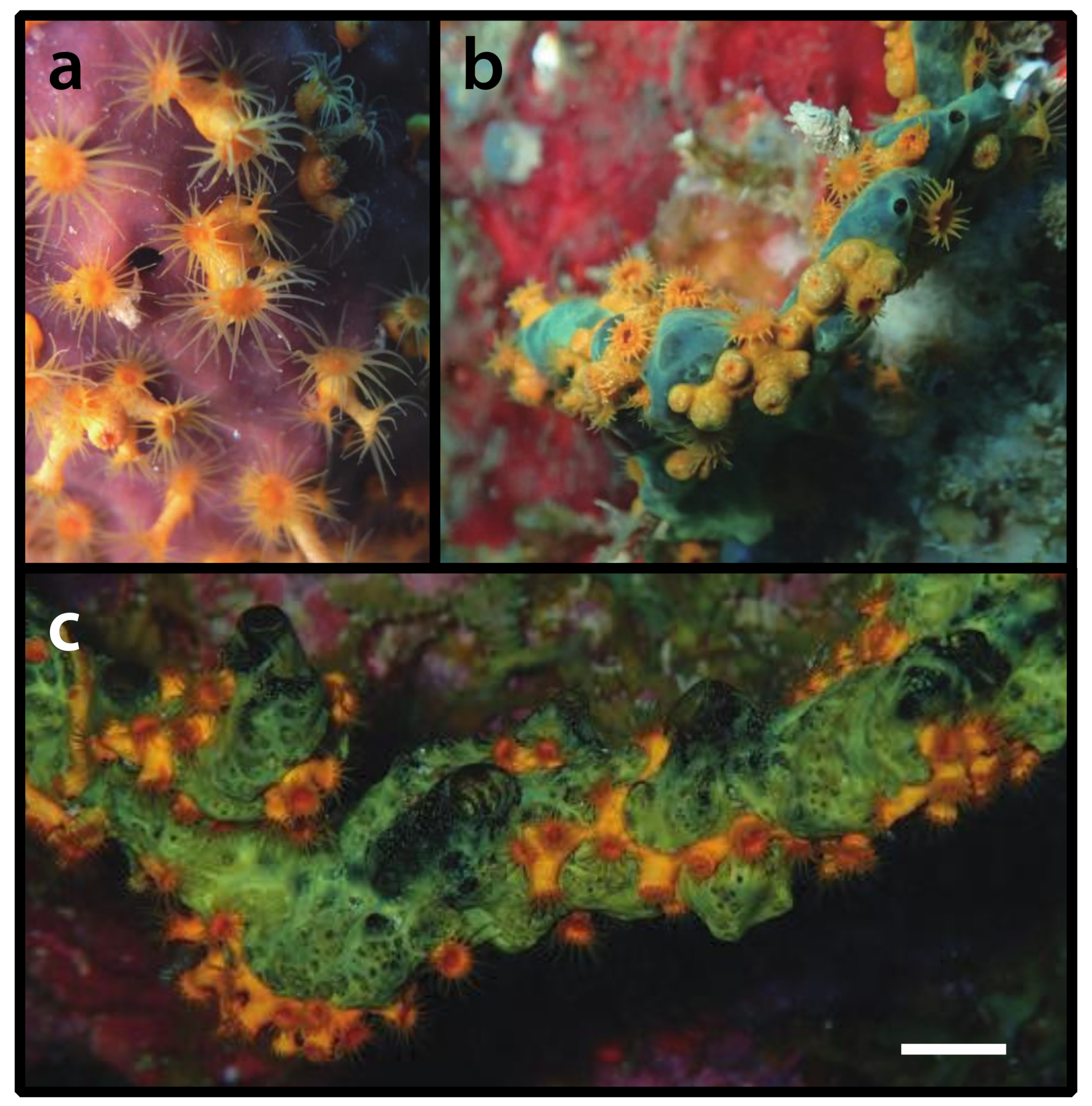
(來源:https://www.mdpi.com/1424-2818/12/5/190)
生長在枝狀海綿上的Parazoanthus swiftii
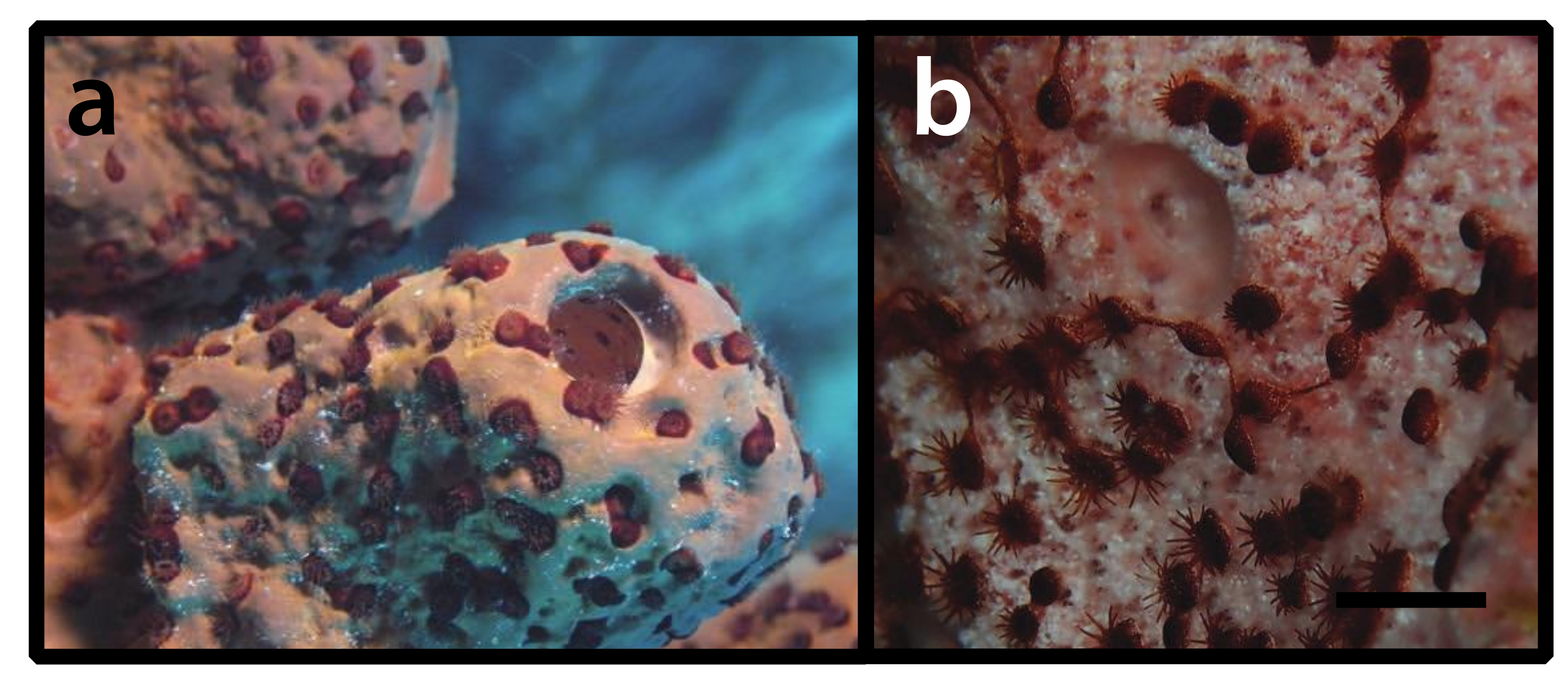
(來源:https://www.mdpi.com/1424-2818/12/5/190)
生長在塊狀海綿上的Bergia puertoricense

(來源:https://reefs.com/magazine/improved...sults-with-two-12-cubic-meter-dymico-systems/)
俗稱的蜘蛛海綿上生長的其實也是某種菟葵(可能是Parazoanthus或Epizoanthus)
參考資料
1. Identify This: Zoanthids by Drew Wham
2. The Enigma of Aenigmanthus & The Rise Of Epizoism by Joe Rowlett
3. Improved husbandry of marine invertebrates using an innovative filtration technology – part two: results with two 12 cubic meter DyMiCo systems by Tim Wijgerde
4. Sphenopus exilis is a New Species of Zoanthid Unlike Any Other by Jake Adams
5. Red Epizoanthus from Cortez Marine are sure to please the Azoox and NPS reefers by Jake Adams
6. A stroll in the sponge gardens by Arthur Güth
7. Blue Shuriken Exotic Frags
8. 屬 Microzoanthus by Abhishek Jamalabad
9. Reimer JD, Sinniger F (2024) World List of Zoantharia. Palythoa tuberculosa (Esper, 1805). Accessed through: World Register of Marine Species
10. Low MEY, Sinniger F, Reimer JD (2016) The order Zoantharia Rafinesque, 1815 (Cnidaria, Anthozoa: Hexacorallia): supraspecific classification and nomenclature. ZooKeys 641: 1-80.
11. Reimer JD, Irei Y, Fujii T (2012) Two new species of Neozoanthus (Cnidaria, Hexacorallia, Zoantharia) from the Pacific. ZooKeys 246: 69-87.
12. Koch TL, Grimmelikhuijzen CJP (2020) A comparative genomics study of neuropeptide genes in the cnidarian subclasses Hexacorallia and Ceriantharia. BMC Genomics 21, 666.
13. Reimer JD, Hirose M, & Wirtz P (2010) Zoanthids of the Cape Verde Islands and their symbionts: previously unexamined diversity in the Northeastern Atlantic. Contributions to Zoology, 79(4), 147-163.
14. Fujii T, Reimer JD (2013) A new family of diminutive zooxanthellate zoanthids (Hexacorallia: Zoantharia). Zoological Journal of the Linnean Society, Volume 169, Issue 3, 1, Pages 509–522.
15. Kise H, Montenegro J, Ekins M, Moritaki T & Reimer JD (2019) A molecular phylogeny of carcinoecium-forming Epizoanthus (Hexacorallia: Zoantharia) from the Western Pacific Ocean with descriptions of three new species, Systematics and Biodiversity, 17:8, 773-786.
16. Montenegro J, Hoeksema BW, Santos MEA, Kise H, Reimer JD (2020) Zoantharia (Cnidaria: Hexacorallia) of the Dutch Caribbean and One New Species of Parazoanthus. Diversity. ; 12(5):190.
我們講的鈕扣是屬於菟葵目(Zoantharia)底下的一群動物,與石珊瑚、海葵 、 擬珊瑚、與黑珊瑚同屬於六放珊瑚,而接下來我便會簡單介紹一下菟葵這個類群。
一、基本分類

(來源:https://bmcgenomics.biomedcentral.com/articles/10.1186/s12864-020-06945-9)
上圖為六放珊瑚目前的親緣關係與分類(由上至下分別為石珊瑚、擬珊瑚、黑珊瑚、海葵、菟葵、管海葵、與八放珊瑚),可以看到菟葵目其實是六放珊瑚中的基群(basal group),也就是在演化歷史上最早分家出去的一群。
菟葵目底下目前有兩個大分支,分別為Brachycnemina與Macrocnemina,不過其分類與類群間的親緣關係仍有許多爭議。
二、Brachycnemina
Brachycnemina底下總共有三個科:
1. Sphenopidae
Sphenopidae包含了Palythoa和Sphenopus兩個屬:
(1) Palythoa
這個屬包含各種深水鈕扣、大綠鈕、地圖鈕等。Palythoa體內含有稱作Palytoxin的毒素,新聞上的鈕扣中毒事件多半就是這些傢伙搞的(部分其他菟葵也有Palytoxin但量通常比較少)。
另外他們還有個特點是生長時常會把一些沙子或粉塵納入共肉中所以質感會比較粗糙,因此也俗稱岩砂海葵。

一般俗稱的深水鈕扣,可以看到觸手比較細尖,抓食物的能力也很不錯,上面這顆甚至能捕捉成年豐年蝦

(來源:https://www.marinespecies.org/aphia.php?p=taxdetails&id=220520#images)
潮間帶常見的Palythoa tuberculosa

這個則是另一種經典款加勒比海地圖鈕(Palythoa grandis),市面上可以看到很多不同色系及花紋的strain

(來源:https://reefs.com/magazine/identify-this-zoanthids/)
一般我們俗稱的大綠紐也是常見的Palythoa
其他像是Nuclear Green、Purple/Red Death等比較有名的鈕扣也都是Palythoa。另外早期還有個屬叫Protopalythoa不過目前已經被併入Palythoa了。
(2) Sphenopus
Sphenopus與許多其他菟葵最不一樣的點在於他們通常會是單一一隻水螅體自己生長並非集體生活,不過由於沒什麼顏色變化故相當少見於水族貿易。

(來源:https://reefbuilders.com/2016/07/27/sphenopus-exilis-is-a-new-species-of-zoanthid-unlike-any-other/)
沖繩美麗海水族館所展示的Sphemopus marsupialis
2. Zoanthidae
Zoanthidae底下總共有三個屬:
(1) Zoanthus
水族市場中多數的鈕扣在分類上屬於這裡。Zoanthus的顏色變化非常豐富,市面上也有許多著名的命名strain,不過有時候很難分辨,因為就連不同物種也有可能出現類似的顏色型態。

不同strain的Zoanthus

左上那顆雖然也常被叫大綠鈕但其實是屬於Zoanthus
(2) Isaurus
台灣好像幾乎沒看過有人特別進這東西,我之前養的也是從水館角落挖到的(可能是跟著別的東西進來的)。英文俗稱為snake polyp,我習慣翻成蛇鈕扣。
與其他鈕扣不同的是共生藻及螢光蛋白都在水螅體脖子部分,觸手及oral disc則是白的,通常白天會整坨垂下來到了晚上會立起來開花。

(來源:https://reefbuilders.com/2017/03/06/saint-patricks-snake-polyps-craziest-zoanthids-ever/)
俗稱Saint Patrick的strain
(3) Acrozoanthus
Acrozoanthus的特徵為他們通常會長在磯沙蠶(Eunice)所製造的管子上,所以也常會被稱作水螅樹。與Zoanthus的親緣關係相當近,不過由於生長方式的差異故目前單獨分於一屬。

一小叢的Acrozoanthus

他們的附著能力相對其他菟葵而言其實還滿弱的,所以飼養時很容易發生像這樣被海膽等生物綁架的狀況
3. Neozoanthidae
Neozoanthidae底下有一屬三種,偶可見於水族市場。

(來源:https://zookeys.pensoft.net/article/3398/)
大堡礁的Neozoanthus caleyi

(來源:https://www.exoticfrags.us/s/product_info.php?products_id=459)
藍色的水族strain "Blue Shuriken"
三、Macrocnemina
Macrocnemina底下總共有五個科:
1. Microzoanthidae
這個科目前僅一屬兩種。水螅體較小且多無共生藻,少見於水族貿易。

(來源:https://www.inaturalist.org/observations/27554203)
印度西岸的Microzoanthus sp.
2. Nanozoanthidae
目前僅一屬一種。與Microzoanthus一樣水螅體相當小且少見於水族貿易,不過差異在於體內是有共生藻的。

(來源:https://academic.oup.com/zoolinnean/article/169/3/509/2420782?login=false)
沖繩的Nanozoanthus harenaceus
3. Epizoanthidae
Epizoanthidae底下有兩個屬:
(1) Epizoanthus
Epizoanthus底下的物種多半不具共生藻。他們經常生長在海綿、珊瑚、水螅、甚至寄居蟹身上,因此同樣常被稱作水螅樹。

(來源:https://reefbuilders.com/2010/10/27/red-epizoanthus-cortez-marine-azoox-nps-reefers/)
生長在海樹上的Epizoanthus

(來源:https://www.tandfonline.com/doi/full/10.1080/14772000.2019.1693439)
生長在寄居蟹殼上的Epizoanthus xenomorphoideus
(2) Thoracactis
Thoracactis屬下目前僅Thoracactis topsenti一種。無共生藻且通常生長於海綿上,少見於水族貿易。

(來源:https://marinee-tech.blogspot.com/2018/11/a-stroll-in-sponge-gardens.html)
生長於海綿上的Thoracactis topsenti
4. Hydrozoanthidae
Hydrozoanthidae底下有Aenigmanthus、Hydrozoanthus、Terrazoanthus三個屬。
(1) Aenigmanthus & Hydrozoanthus
這兩個屬多半不具共生藻並偏好生長在一些深水的水螅或海樹上,少見於水族貿易。

(來源:https://reefs.com/the-enigma-of-aenigmanthus-the-rise-of-epizoism/)
生長於群體水螅上的Hydrozoanthus sils

(來源:https://reefs.com/the-enigma-of-aenigmanthus-the-rise-of-epizoism/)
生長於海樹上的Aenigmanthus segoi
(2) Terrazoanthus
這個屬與上面兩個的差異在於他們通常不會長在其他生物身上且許多種類是有共生藻的,水族貿易中常見的黃水螅即是屬於這個屬。

(來源:https://tidalgardens.com/stock-yellow-parazoanthus-polyp.html)
上圖這種Terrazoanthus就是我們一般俗稱的黃水螅。這東西的分類其實一直都有點爭議,不過2010年時Reimer等人透過基因定序分在Terrazoanthus這個屬。
牠們的生長速度非常快,算是雜草等級的東西,而且戰鬥力其實不算弱所以最好注意一下擺放位置。
5. Parazoanthidae
Parazoanthidae是個非常大的科。底下的屬多無共生藻且生長在其他生物上,而不同的屬則各有不同的宿主偏好。

(來源:https://www.mdpi.com/1424-2818/12/5/190)
生長在枝狀海綿上的Parazoanthus swiftii

(來源:https://www.mdpi.com/1424-2818/12/5/190)
生長在塊狀海綿上的Bergia puertoricense

(來源:https://reefs.com/magazine/improved...sults-with-two-12-cubic-meter-dymico-systems/)
俗稱的蜘蛛海綿上生長的其實也是某種菟葵(可能是Parazoanthus或Epizoanthus)
參考資料
1. Identify This: Zoanthids by Drew Wham
2. The Enigma of Aenigmanthus & The Rise Of Epizoism by Joe Rowlett
3. Improved husbandry of marine invertebrates using an innovative filtration technology – part two: results with two 12 cubic meter DyMiCo systems by Tim Wijgerde
4. Sphenopus exilis is a New Species of Zoanthid Unlike Any Other by Jake Adams
5. Red Epizoanthus from Cortez Marine are sure to please the Azoox and NPS reefers by Jake Adams
6. A stroll in the sponge gardens by Arthur Güth
7. Blue Shuriken Exotic Frags
8. 屬 Microzoanthus by Abhishek Jamalabad
9. Reimer JD, Sinniger F (2024) World List of Zoantharia. Palythoa tuberculosa (Esper, 1805). Accessed through: World Register of Marine Species
10. Low MEY, Sinniger F, Reimer JD (2016) The order Zoantharia Rafinesque, 1815 (Cnidaria, Anthozoa: Hexacorallia): supraspecific classification and nomenclature. ZooKeys 641: 1-80.
11. Reimer JD, Irei Y, Fujii T (2012) Two new species of Neozoanthus (Cnidaria, Hexacorallia, Zoantharia) from the Pacific. ZooKeys 246: 69-87.
12. Koch TL, Grimmelikhuijzen CJP (2020) A comparative genomics study of neuropeptide genes in the cnidarian subclasses Hexacorallia and Ceriantharia. BMC Genomics 21, 666.
13. Reimer JD, Hirose M, & Wirtz P (2010) Zoanthids of the Cape Verde Islands and their symbionts: previously unexamined diversity in the Northeastern Atlantic. Contributions to Zoology, 79(4), 147-163.
14. Fujii T, Reimer JD (2013) A new family of diminutive zooxanthellate zoanthids (Hexacorallia: Zoantharia). Zoological Journal of the Linnean Society, Volume 169, Issue 3, 1, Pages 509–522.
15. Kise H, Montenegro J, Ekins M, Moritaki T & Reimer JD (2019) A molecular phylogeny of carcinoecium-forming Epizoanthus (Hexacorallia: Zoantharia) from the Western Pacific Ocean with descriptions of three new species, Systematics and Biodiversity, 17:8, 773-786.
16. Montenegro J, Hoeksema BW, Santos MEA, Kise H, Reimer JD (2020) Zoantharia (Cnidaria: Hexacorallia) of the Dutch Caribbean and One New Species of Parazoanthus. Diversity. ; 12(5):190.
最後編輯:
